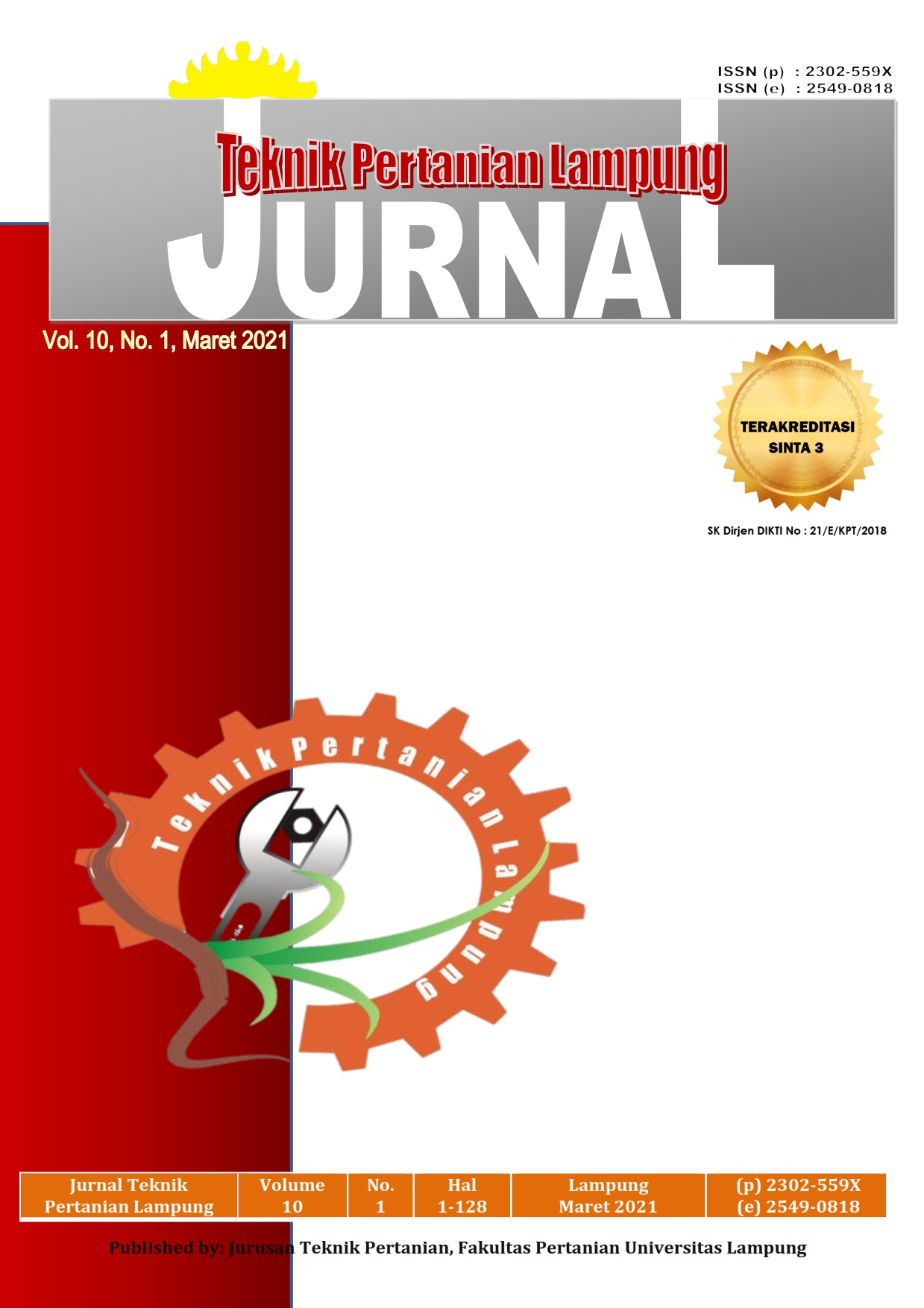RANCANG BANGUN MESIN PULPER KOPI MENGGUNAKAN PENGGERAK MOTOR LISTRIK
DOI:
https://doi.org/10.23960/jtep-l.v10i1.26-32Abstract
Design and manufacture of coffee pulper machines have been carried out with the aim of completing the needs of the coffee farmer groups when harvesting in the Kayu Aro area, Kerinci. The steps in designing and manufacturing a coffee pulper begins with a literature study, design and calculation, the process of making the tool and ends with testing the tool. Engineering drawing design is done by modeling in SolidWorks software. Coffee peeler machine with a capacity of 4 kg/min, with a machine size of 730 mm x 320 mm x 1040 mm, using an electric motor 1 HP 1420 rpm, with a frame using an elbow profile 40 mm x 40 mm x 3 mm. The transmission system uses an electric motor with an initial rotation of 1420 rpm to 364.6 rpm. In the 2 pulley component D = 74.6 mm and 290.5 mm, V-belt type B No.52, 1 solid shaft D = 25 mm. Initial test results using 2−5 kg of wet coffee beans take 30.07−77.20 seconds, and the skin has separated from the beans cleanly. These results show that the engine capacity is 235.62 kg/h, so that the desired target is met with relatively low operating costs. The existence of this tool will be able to help the process of separating the skin and coffee beans, so that the quality of coffee production will increase.
Keywords: coffee, coffee machine, design and construction, farmer groups
References
Achmad, Z. 2016. Elemen Mesin I. PT Refika Aditama, Bandung.
Amran, A.F., Munir, A.P., dan Harahap, L.A. 2017. Rancang bangun alat pengupas kulit tanduk kopi mekanis. Jurnal Rekayasa Pangan dan Pertanian, 5(1): 149-155.
Effendi, R., dan Khumaidi, M. 2018. Perancangan mesin perajang bawang serbaguna menggunakan motor listrik dengan kapasitas 55 kg/jam. Jurnal POLIMESIN, 16(2): 47-50.
Harsokusoemo, D. 2004. Pengantar Perancangan Teknik. Institut Teknologi Bandung, Bandung.
Nasution, A.Y., dan Efendi, R. 2018. Perancangan alat pengupas kopi basah dengan kapasitas 120 kg/jam. Turbo, 7(2): 140-145.
Sabani. 2018. Profil Kopi Kerinci. (Diakses dari www.sabani.com, 25 Agustus 2019).
Siswoyo. 2018. Teknik Listrik Industri Jilid 2 untuk SMK. Direktorat Pembinaan Sekolah Menengah Kejuruan, Direktorat Jenderal Manajemen Pendidikan Dasar dan Menengah, Departemen Pendidikan Nasional, Jakarta.
Sodik, A., Suharno, K., dan Widodo, S. 2016. Perancangan mesin pengupas kopi dengan menggunakan dua rol pengupas. Jurnal Wahana Ilmuwan, 1(1): 55-64.
Sonawan, H. 2010. Perancangan Elemen Mesin. Alfabeta, Bandung.
Sudirman, Y., Waluyo, S., dan Warji. 2014. Uji kinerja prototipe alat pembersih gabah. Jurnal Teknik Pertanian Lampung, 3(1): 1- 8.
Sugandi, W.K., Yusuf, A., dan Thoriq, A. 2017. Rancang bangun mesin pengiris talas. Jurnal Teknik Pertanian Lampung, 6(1): 53-62.
Sularso, dan Suga, K. 1997. Dasar Perencanaan Dan Pemilihan Elemen Mesin. PT Pradnya Paramita, Jakarta.
Sutejo, A., Mardjan, S.S., Hermawan, W., Desrial. 2018. Kinerja mesin pemisah potongan tangkai dan daun teh. Jurnal Teknik Pertanian Lampung, 7(3): 160-167.
Downloads
Published
Issue
Section
License
- Authors who publish with this journal agree to the following terms:
- Authors retain copyright and grant the journal right of first publication with the work simultaneously licensed under a Creative Commons Attribution-ShareAlike 4.0 International Lice that allows others to share the work with an acknowledgement of the work's authorship and initial publication in this journal.
- Authors are able to enter into separate, additional contractual arrangements for the non-exclusive distribution of the journal's published version of the work (e.g., post it to an institutional repository or publish it in a book), with an acknowledgement of its initial publication in this journal.
- Authors are permitted and encouraged to post their work online (e.g., in institutional repositories or on their website) prior to and during the submission process, as it can lead to productive exchanges, as well as earlier and greater citation of published work (See The Effect of Open Access).
Jurnal Teknik Pertanian Lampung

JTEPL is licensed under a Creative Commons Attribution-ShareAlike 4.0 International License.

